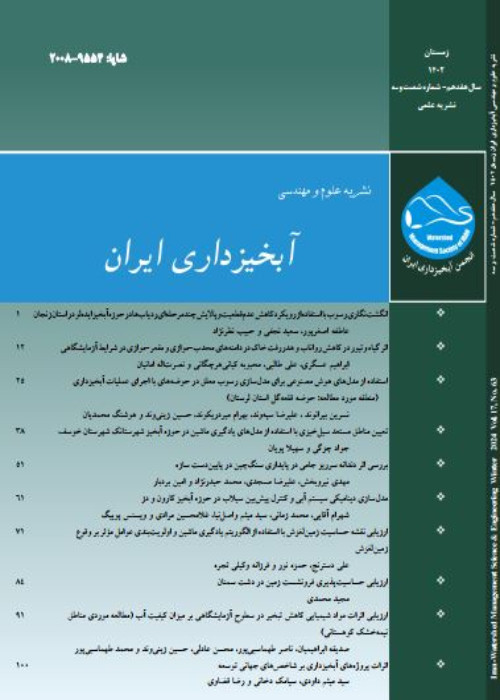Reservoir Operation Management Using Multicriteria Decision Making Methods in Bustan Dam-Golestan Province
Author(s):
Abstract:
Considering the current trend of ever decreasing water resources and their associated qualitative and quantitative variations, managers are now facing the challenge of offering adaptable planning and allocation decision methods for integrated watershed management. This study focuses on the understanding of the trade-offs among the various outcomes of allocation decisions for Boostan Dam reservoir on the Gorgan-Rud River in Golestan Province of Iran. Control of water level in the reservoir such that enough water is available during dry months to satisfy different needs of the downstreamas well as the capability of dam to mitigate floods considered as the objectives of the study. The recorded flow data suggested that there are four months with high likelihood of flooding events. Sixteen mutually exclusive scenarios were developed to accommodate different and competing water demands of water users in the area. The monthly riverflow discharge for one Iranian water-year started from October 2007 were forecasted by a Seasonal Auto Regressive Integrating Moving Average (SARIMA) model. The water allocation analysis was conducted on the basis of the forecasted monthly flow data. To quantify the effects of implementing the scenarios, five indices were selected and quantified. The indices included water storage capacity during flood-prone months, stored water volume at the end of the wateryear,the likelihood of overflowing, outflow discharge simulated by a flood routing technique and the risk of dam collapse because of floods. The multi-criteria decision making technique was used to trade-off the outcomes and therefore to identify the best allocation scenario. To weight the indices, the process of expert knowledge elicitation was completed using AHP (Analytical Hierarchy Process) technique. The TOPSIS (Technique Ordered Preference by Similarity to the Ideal Solution) model was used to identify the best scenario among the 16 allocation scenarios. The results show that the scenarios can be categorised in nine different groups among them scenario 7 has been identified as the best allocation scenario followed by scenario1. Scenario7 is characterised by emphasis on flood control objective for the floodpronemonths (May and August) as well as water supply to meet the water demands of the downstream. The integrating approach implemented in this study is capable of assisting the decision makers and dam operators to understand and investigate the possible allocation scenarios, and to recognise the likely outcomes and the trade-offs among them. Thus, the approach supports the decision makers to achieve their objectives capturing different criteria associated with the allocation problems.
Language:
Persian
Published:
Iranian Journal of Watershed Management Science and Engineering, Volume:4 Issue: 11, 2010
Page:
25
magiran.com/p864244
دانلود و مطالعه متن این مقاله با یکی از روشهای زیر امکان پذیر است:
اشتراک شخصی
با عضویت و پرداخت آنلاین حق اشتراک یکساله به مبلغ 1,390,000ريال میتوانید 70 عنوان مطلب دانلود کنید!
اشتراک سازمانی
به کتابخانه دانشگاه یا محل کار خود پیشنهاد کنید تا اشتراک سازمانی این پایگاه را برای دسترسی نامحدود همه کاربران به متن مطالب تهیه نمایند!
توجه!
- حق عضویت دریافتی صرف حمایت از نشریات عضو و نگهداری، تکمیل و توسعه مگیران میشود.
- پرداخت حق اشتراک و دانلود مقالات اجازه بازنشر آن در سایر رسانههای چاپی و دیجیتال را به کاربر نمیدهد.
In order to view content subscription is required
Personal subscription
Subscribe magiran.com for 70 € euros via PayPal and download 70 articles during a year.
Organization subscription
Please contact us to subscribe your university or library for unlimited access!



